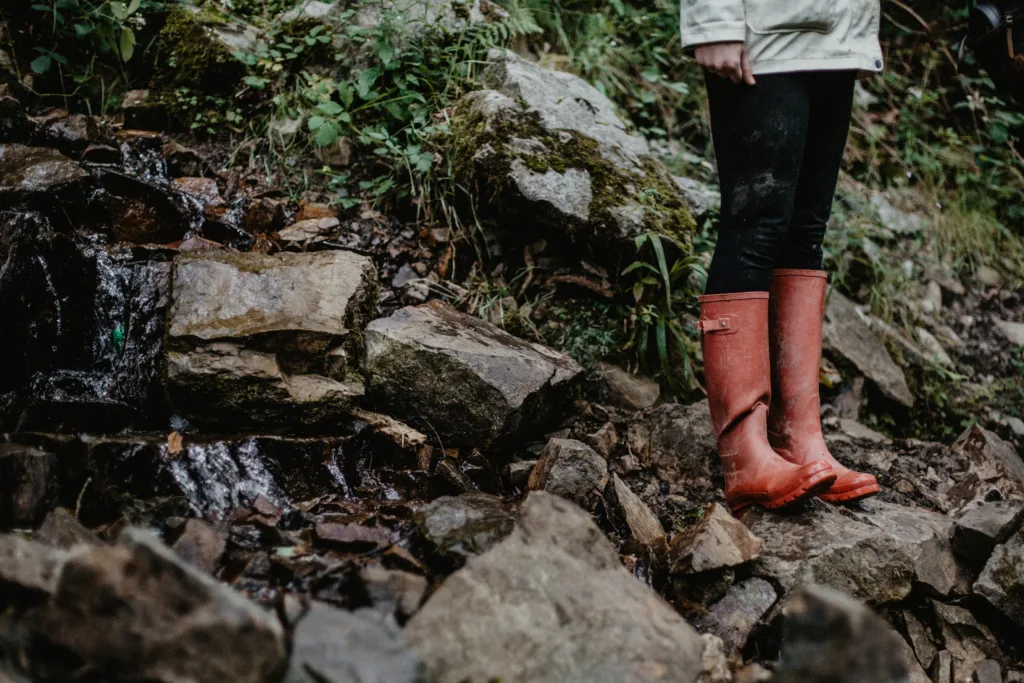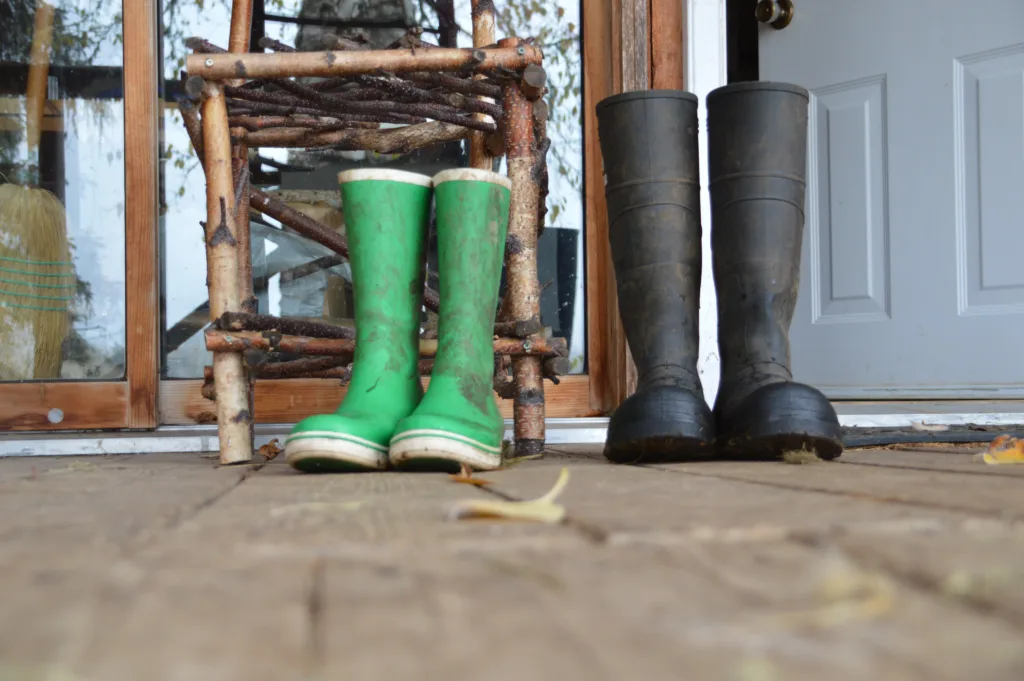Wellies, also known as Wellington boots, are a type of waterproof footwear that have become synonymous with rainy days and muddy outdoor adventures. These boots, which are typically made of rubber or PVC, provide excellent protection against water, making them a popular choice for those who need to keep their feet dry in wet conditions.
The name “Wellies” actually stems from their inventor, Arthur Wellesley, the first Duke of Wellington. In the early 19th century, Wellington asked his shoemaker to modify his riding boots to create a more practical and waterproof design. The resulting boots, with their high length and sturdy construction, proved to be a hit and were soon adopted by the British military and aristocracy.
One of the key features of wellies is their tall design, which typically reaches up to the mid-calf or knee. This length provides extra protection against water and mud, allowing wearers to confidently navigate through wet and muddy terrain. The boots are often equipped with a sturdy sole that offers good traction, preventing slips and falls on slippery surfaces.
While wellies were initially designed for practical purposes, they have now become a fashion statement in their own right. With a wide range of colors and patterns available, wellies can add a touch of style to any outfit, even on the rainiest of days. Many brands also offer wellies with additional features, such as insulation for colder weather or adjustable calf straps for a customizable fit.
Wellies are not just limited to rainy days. They are also commonly worn for outdoor activities such as gardening, farming, fishing, and hiking, where protection against water and mud is essential. Their durable construction ensures that they can withstand rugged conditions and provide long-lasting comfort and support.
In Canada, the terms “gumboots” and “rainboots” are often used interchangeably with “wellies.” These variations highlight the versatility and popularity of this type of footwear across different regions.
Wellies are a practical and stylish choice for those looking to keep their feet dry and protected in wet conditions. With their rich history and continued popularity, wellies have become an iconic symbol of British heritage and a staple in the wardrobes of outdoor enthusiasts worldwide. So next time you’re planning a rainy day adventure, don’t forget to pack your trusty wellies!
What Are Wellies Called In America?
Wellies, also known as wellingtons, are a type of rubber boots commonly used in rainy or muddy conditions. In North America, specifically in the United States, they are typically referred to as rubber boots. However, there are also alternative names used in different regions. Some other terms that are sometimes used interchangeably with rubber boots in the United States include galoshes, mud boots, mucking boots, and billy boots.
In Canada, on the other hand, the preferred terms for wellies or rubber boots are gumboots, wellies, wellingtons, or rainboots. These terms are more commonly used in Canadian English to describe this type of footwear.
While the term “wellies” is not commonly used in America, the terms “rubber boots” or one of the various alternative names mentioned above are used to refer to the same type of footwear. In Canada, the preferred terms are gumboots, wellies, wellingtons, or rainboots.

Why Do Brits Call Boots Wellies?
Brits call boots “wellies” as a shortened form of Wellington boots. Wellington boots are named after Arthur Wellesley, the first Duke of Wellington, who was a prominent military figure in Britain during the 19th century. The story goes that the Duke asked his shoemaker to modify his riding boots to make them more practical for battle and outdoor activities. The modified boots became popular among soldiers, and eventually among the general public as well. Over time, the name “Wellington boots” was shortened to “wellies” as a colloquial term. The term “wellies” has since become widely used in Britain to refer to any type of rubber or waterproof boots, not just the original Wellington style.
Here are some additional facts and trivia about wellies:
1. Wellington boots were originally made from leather, but modern versions are typically made from rubber or PVC, making them fully waterproof.
2. The distinctive design features of wellies include a high shaft to protect the lower leg from rain and mud, and a thick sole with deep treads for traction in wet conditions.
3. Wellies are commonly worn in rainy or muddy environments, such as farms, gardens, and festivals, but they have also become a fashionable footwear choice for all occasions.
4. The popularity of wellies soared during World War I when soldiers needed durable and waterproof footwear for the trenches.
5. In the United States, wellies are often referred to as “rain boots” or “galoshes.”
6. Wellies are available in a wide range of colors, patterns, and designs, catering to different tastes and styles.
7. Some wellies come with additional features, such as insulated linings for warmth in cold weather or adjustable straps for a customized fit.
8. The term “wellies” has been used in popular culture, including in songs, books, and films, further cementing its association with waterproof boots.
9. The annual Glastonbury Festival in the UK is famous for its muddy conditions, and many attendees wear wellies to navigate the muddy terrain.
10. Wellies have become an iconic symbol of British culture, representing resilience, practicality, and a love for the outdoors.
Are Wellies A British Thing?
Wellies are indeed a British thing. They have a strong association with British culture and are considered an iconic footwear choice in the country. Wellies, short for Wellington boots, were named after the 1st Duke of Wellington, Arthur Wellesley, who popularized them in the early 19th century.
Wellies were initially designed as a practical solution for outdoor activities such as hunting, fishing, and farming. The waterproof and sturdy nature of Wellington boots made them ideal for navigating wet and muddy terrains. They quickly gained popularity among the British aristocracy and became a fashionable footwear choice for country pursuits.
The distinctive design of wellies, with their high length and rubber material, sets them apart from other types of boots. This design not only provides protection against water and mud but also offers support and comfort for extended periods of wear. The boots typically have a round toe and a chunky sole, making them suitable for various outdoor activities and weather conditions.
Wellies have become deeply rooted in British culture and are commonly associated with country life, outdoor festivals, and rainy weather. They are often seen at events like Glastonbury Festival, where attendees embrace the practicality and style of wellington boots. The popularity of wellies has extended beyond the aristocracy and they are now worn by people from all walks of life in the UK.
Wellies are a British invention that has gained international recognition. Their practicality, durability, and association with British outdoor pursuits have made them an integral part of British culture. Whether for work or fashion, wellies continue to be a beloved and distinctly British footwear choice.
What Are Wellies British Slang?
Wellies, which is a British slang term, refers to a type of footwear known as Wellington boots. These boots were originally designed and named after Arthur Wellesley, the first Duke of Wellington, who was a renowned military leader in the 19th century. Wellington boots, or wellies, are typically made of rubber and are designed to be waterproof, providing protection and comfort in wet and muddy conditions.
Wellies have become an iconic symbol of British culture and are widely used in outdoor activities such as hiking, gardening, and festivals, where wet and muddy conditions are common. The term “wellies” is primarily used in the UK, but it is also recognized in other English-speaking countries.
Here are some key features and characteristics of wellies:
1. Material: Wellies are commonly made of rubber, which makes them waterproof and durable. However, variations in materials, such as neoprene or PVC, can also be found.
2. Height: Wellies usually have a tall shaft that extends up to the calf or knee, providing protection from water and mud splashes. However, shorter versions are also available.
3. Sole: Wellies typically have a thick, sturdy sole with deep treads for better traction in slippery or muddy conditions.
4. Design: While the traditional wellies are solid-colored, modern variations come in a wide range of colors, patterns, and designs, making them more fashionable and appealing.
5. Usage: Wellies are commonly worn in various outdoor activities, including hiking, camping, fishing, farming, gardening, and attending festivals or concerts. They are particularly popular during the rainy seasons and in rural areas.
Wellies are a type of waterproof boots, primarily made of rubber, that are commonly worn in the UK and other English-speaking countries. They offer protection and comfort in wet and muddy conditions, making them an essential footwear choice for outdoor activities.

Conclusion
Wellies, also known as Wellington boots or “Wellies,” are a type of waterproof footwear that originated in Britain in the 19th century. They were named after Arthur Wellesley, the first Duke of Wellington, who popularized their use. Originally designed as modified riding boots, wellies became widely worn by the British aristocracy and military figures for outdoor activities such as hunting.
Wellies are made from rubber or PVC material, which makes them highly durable and waterproof. They typically reach up to the mid-calf or knee, providing excellent protection against rain, mud, and other wet conditions. Wellies are particularly popular in the UK and are commonly associated with the country’s rainy climate.
Not only are wellies practical and functional, but they also hold a significant cultural and historical value. Their invention and subsequent popularity among the British elite have contributed to their iconic status. Wellies have become a symbol of British heritage and are often associated with traditional countryside activities, festivals, and outdoor events.
Although wellies were initially designed for specific purposes, they have transcended their original function and become a fashion statement. Today, wellies come in various styles, colors, and patterns, catering to different fashion preferences. They have become a versatile footwear choice for both practical use and fashion-forward individuals.
In recent years, wellies have gained popularity beyond the UK, with many people around the world recognizing their practicality and style. In North America, they are often referred to as rain boots or rubber boots. In Canada, the terms “gumboots,” “wellingtons,” and “rainboots” are commonly used.
Wellies are a type of waterproof footwear with a rich history and cultural significance. They provide excellent protection against wet conditions and have become a fashion staple. Whether you’re trudging through muddy fields, attending a music festival, or simply wanting to make a fashion statement, wellies are the go-to choice for comfort, durability, and style.
